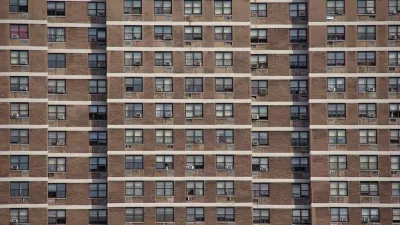Jonathan Massey pens an essay in the journal Places, in which he probes the implications of homeownership as the vehicle by which the microeconomics of household finance and the macroeconomics of a globalized economy are mediated.
In the article, Massey traces the changing history of the relationships of individuals and households to the market and to the state as reflected in homeownership.
Arriving at recent history in the slogans and stories of Occupy protestors (the 99%) decrying federal programs to deal with the affects of the housing crisis on banks and large institutions (the 1%), Massey sees a reflection of, "how homeownership and mortgage finance mediate the economic risks and opportunities of globalization."
In tying their concern specifically to the housing market, and the ideal of homeownership, Massey finds an interesting demographic thrust to the story of a decidedly middle-class "American Dream" gone sour, "The concerns of the poor and working class, like those of people of color, are less evident. So it is perhaps not surprising that so many occupiers, activists and supporters are demanding homeownership support rather than housing opportunities for all."
For which one might point out to Massey that in fact such dashed hopes may belong to a current or former middle class, as well as an aspirational lower class.
FULL STORY: Housing and the 99 Percent

Study: Maui’s Plan to Convert Vacation Rentals to Long-Term Housing Could Cause Nearly $1 Billion Economic Loss
The plan would reduce visitor accommodation by 25,% resulting in 1,900 jobs lost.

North Texas Transit Leaders Tout Benefits of TOD for Growing Region
At a summit focused on transit-oriented development, policymakers discussed how North Texas’ expanded light rail system can serve as a tool for economic growth.

Why Should We Subsidize Public Transportation?
Many public transit agencies face financial stress due to rising costs, declining fare revenue, and declining subsidies. Transit advocates must provide a strong business case for increasing public transit funding.

How to Make US Trains Faster
Changes to boarding platforms and a switch to electric trains could improve U.S. passenger rail service without the added cost of high-speed rail.

Columbia’s Revitalized ‘Loop’ Is a Hub for Local Entrepreneurs
A focus on small businesses is helping a commercial corridor in Columbia, Missouri thrive.

Invasive Insect Threatens Minnesota’s Ash Forests
The Emerald Ash Borer is a rapidly spreading invasive pest threatening Minnesota’s ash trees, and homeowners are encouraged to plant diverse replacement species, avoid moving ash firewood, and monitor for signs of infestation.
Urban Design for Planners 1: Software Tools
This six-course series explores essential urban design concepts using open source software and equips planners with the tools they need to participate fully in the urban design process.
Planning for Universal Design
Learn the tools for implementing Universal Design in planning regulations.
City of Santa Clarita
Ascent Environmental
Institute for Housing and Urban Development Studies (IHS)
City of Grandview
Harvard GSD Executive Education
Toledo-Lucas County Plan Commissions
Salt Lake City
NYU Wagner Graduate School of Public Service





























